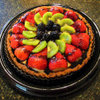Marmalade handholding
Fori
14 years ago
I think I want marmalade. A small batch. There are many recipes out there, but all make a ton. Can I shrink a recipe? And can I use navel oranges? I want to use what's hanging over my fence--navels and I don't know what kind of lemons.
Any suggestions? Should I just go for it? Canning is still a Big Deal for me! Thanks!


annie1992
ForiOriginal Author
lpinkmountain
dgkritch
KatieC
ForiOriginal Author
mustangs81
mustangs81
lpinkmountain
ForiOriginal Author
User
colleenoz
ForiOriginal Author
User
mustangs81
ForiOriginal Author
annie1992
lpinkmountain
mustangs81
mustangs81
User
mustangs81
annie1992
User
lpinkmountain
User
mustangs81
ForiOriginal Author
User
mustangs81
lpinkmountain
ForiOriginal Author
annie1992
mustangs81
lpinkmountain